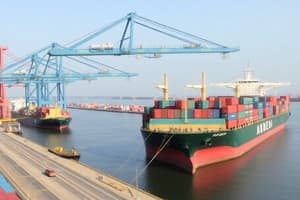Podcast
Questions and Answers
What does the Grubel-Lloyd index measure in the context of intra-industry trade?
What does the Grubel-Lloyd index measure in the context of intra-industry trade?
- The level of tariffs imposed by a country
- The similarity of a country’s export products to its import products (correct)
- The overall trade volume between two countries
- The percentage of national market integration
Which country experienced a decline in the growth of intra-industry trade from 1970 to 1990?
Which country experienced a decline in the growth of intra-industry trade from 1970 to 1990?
- Italy (correct)
- Germany
- Spain
- France
What did Balassa find regarding the percentages of intra-industry trade for France from 1970 to 1990?
What did Balassa find regarding the percentages of intra-industry trade for France from 1970 to 1990?
- It increased but was lower than Italy's percentage
- It decreased to 40%
- It increased to 83% (correct)
- It remained constant at 61%
What are non-tariff barriers in the context of international trade?
What are non-tariff barriers in the context of international trade?
What aspect of international trade did Badinger and Breuss analyze in their research?
What aspect of international trade did Badinger and Breuss analyze in their research?
What was the primary effect of the Customs Union (CU) on trade among member countries?
What was the primary effect of the Customs Union (CU) on trade among member countries?
How did the CU influence industrial specialization among member countries?
How did the CU influence industrial specialization among member countries?
Which of the following options demonstrates a consequence of lower domestic varieties in trade?
Which of the following options demonstrates a consequence of lower domestic varieties in trade?
What was the anticipated outcome of the CU regarding market characteristics?
What was the anticipated outcome of the CU regarding market characteristics?
Which statement best describes intra-industry trade as noted in the context of the CU?
Which statement best describes intra-industry trade as noted in the context of the CU?
Which term represents a potential effect of tariffs imposed within the CU?
Which term represents a potential effect of tariffs imposed within the CU?
What role do trade barriers play according to the discussions of CU effects?
What role do trade barriers play according to the discussions of CU effects?
Which characteristic is associated with the expected outcomes of the CU?
Which characteristic is associated with the expected outcomes of the CU?
What was the estimated gain for the UK in value-added manufacturing following its entry into the EU?
What was the estimated gain for the UK in value-added manufacturing following its entry into the EU?
Which of the following is NOT a reason why large job losses were not observed after the formation of the Customs Union (CU)?
Which of the following is NOT a reason why large job losses were not observed after the formation of the Customs Union (CU)?
What effect did the Customs Union (CU) have on trade patterns among member countries according to Balassa's findings?
What effect did the Customs Union (CU) have on trade patterns among member countries according to Balassa's findings?
Which of the following was identified as a main advantage of the UK's entry into the EU?
Which of the following was identified as a main advantage of the UK's entry into the EU?
What was a common misconception about the Customs Union in the years leading up to its formation in 1958?
What was a common misconception about the Customs Union in the years leading up to its formation in 1958?
What is intra-industry trade (IIT)?
What is intra-industry trade (IIT)?
Which aspect of the UK’s trade was found to be small as a result of the Customs Union?
Which aspect of the UK’s trade was found to be small as a result of the Customs Union?
What factor contributed to the minimal invocation of safeguard clauses during the formation of the Customs Union?
What factor contributed to the minimal invocation of safeguard clauses during the formation of the Customs Union?
Flashcards are hidden until you start studying
Study Notes
The European Union (EU) and Intra-industry Trade
- The EU's formation was a major event in global trade.
- It led to the expansion of trade among member states.
- There were concerns about job losses and factory closures when the EU was formed.
- The EU formation did not lead to the anticipated industrial specialisation, with countries specializing in different industries.
- Trade patterns became more similar, rather than different, between member states.
- This is due to intra-industry trade (IIT) which occurs when a country imports and exports products in the same industry.
- Balassa (1975) found that bilateral trade patterns between France and Germany became more similar from 1958 to 1970, not more different.
Measuring Intra-industry Trade
- The Grubel-Lloyd index of IIT measures how similar a country’s export products are to its import products.
- A score of 0% indicates completely different products, while 100% represents identical products.
- Balassa (1975) found that IIT levels rose between 1958 and 1970 for Italy and France.
- IIT continued to expand in most countries from 1970 to 1990.
- The IIT for France reached 83% by 1990.
Reasons for Intra-Industry Trade
- The text provides no reasons for the occurrence of IIT.
The Effect of EU entry on the UK
- The UK became a member of the EU in 1973.
- One study estimated the effects of the EU on UK trade by re-imposing tariffs on UK trade with the EU.
- This study found that by 1985, trade between the UK and EU had increased due to trade creation but that trade diversion was minimal.
- The UK also experienced external trade creation.
- The main benefit, however, was increased competition and efficiency.
- The overall gain for the UK was estimated at 1.5% of value-added in manufacturing according to one study.
Adjustment Issues
- The EU formation was not as disruptive as many feared.
- There were few trade problems and the safeguard clause (temporary import restrictions) was rarely invoked.
- This was likely due to the golden age of economic growth, low levels of unemployment, and the time given for adjustment.
- Unemployment remained low during the period (1950-1993) and unemployment rates were relatively low in the 1950s and 1960s.
- Specialisation processes and lingering trade barriers also contributed to the lack of disruption.
Impact on Industrial Specialisation
- The EU was expected to lead to industrial specialization with different countries specializing in different industries.
- However, this did not happen, as trade patterns became more similar.
- This can be explained by IIT.
Studying That Suits You
Use AI to generate personalized quizzes and flashcards to suit your learning preferences.




